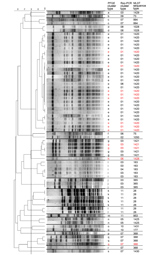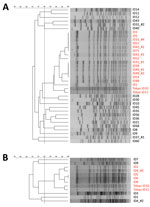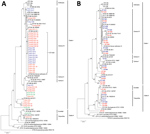
Volume 25, Number 5—May 2019
CME ACTIVITY - Research
Novel Sequence Type in Bacillus cereus Strains Associated with Nosocomial Infections and Bacteremia, Japan
Reiko Akamatsu, Masato Suzuki, Keiji Okinaka, Teppei Sasahara, Kunikazu Yamane, Satowa Suzuki, Daisuke Fujikura1, Yoshikazu Furuta, Naomi Ohnishi2, Minoru Esaki, Keigo Shibayama, and Hideaki Higashi
Abstract
Bacillus cereus is associated with foodborne illnesses characterized by vomiting and diarrhea. Although some B. cereus strains that cause severe extraintestinal infections and nosocomial infections are recognized as serious public health threats in healthcare settings, the genetic backgrounds of B. cereus strains causing such infections remain unknown. By conducting pulsed-field gel electrophoresis and multilocus sequence typing, we found that a novel sequence type (ST), newly registered as ST1420, was the dominant ST isolated from the cases of nosocomial infections that occurred in 3 locations in Japan in 2006, 2013, and 2016. Phylogenetic analysis showed that ST1420 strains belonged to the Cereus III lineage, which is much closer to the Anthracis lineage than to other Cereus lineages. Our results suggest that ST1420 is a prevalent ST in B. cereus strains that have caused recent nosocomial infections in Japan.
Bacillus cereus causes foodborne illness that is characterized by vomiting because of production of emetic toxin and diarrhea because of production of enterotoxin (1). In addition to foodborne illness, B. cereus causes severe nongastrointestinal infections, such as bacteremia (2), endocarditis (3), meningoencephalitis (4), and pneumonia (5). Severe infections occur particularly in immunocompromised patients, sometimes resulting in nosocomial infections. Such nosocomial infections with B. cereus have been reported to be associated with B. cereus contamination of ventilator equipment (6), intravenous catheters (7), and linens (8).
Multilocus sequence typing (MLST) is a molecular typing technique based on 7 housekeeping genes (9). The phylogenetic tree of isolates of B. cereus group species, which include B. anthracis, B. thuringiensis, and several B. cereus subspecies (10), clusters into clades 1, 2, and 3. Clade 1 consists of 4 lineages defined by Priest et al. (9). Previous MLST studies have shown that clinical isolates of B. cereus are phylogenetically diverse and clustered mainly in clades 1 and 2 (11), suggesting that specific clones or lineages of B. cereus are associated with specific illnesses and severe infections. For example, Zhang et al. showed that isolates from outbreaks of nosocomial infections were closely related to B. anthracis by phylogenetic analysis using MLST (12).
There have been only a few reports on MLST analysis of B. cereus isolates that have caused nosocomial infections (12,13). The objective of our study was to elucidate the genetic characteristics of B. cereus strains that were isolated from recent nosocomial infections in 4 hospitals in Japan during 2006, 2012, 2013, and 2016. A novel sequence type (ST) was dominant in isolates from 3 of the hospitals, suggesting a strong association of the ST with recent nosocomial infections in Japan.
Bacterial Strains
We used 4 groups of B. cereus strains in our study (Table 1; Table 2; Tables 3, 4). A total of 69 strains were isolated from equipment and patients in a hospital in Tokyo that had B. cereus infections in 2013. These strains were designated Tokyo strains. Two blood cultures were prepared per patient. A patient was considered to have bacteremia when a B. cereus strain was isolated from both cultures. A patient was designated as having pseudobacteremia when a B. cereus strain was isolated from only 1 of the 2 cultures. A total of 65 strains were isolated from equipment and patients in a hospital in Tochigi that had B. cereus infections in 2006. These strains were designated Tochigi strains (14). During 2012, four strains were isolated from patients in hospitals in Kochi. These strains were designated Kochi strains. During 2016, ten strains were isolated from patients in hospitals in Tottori. These strains were designated Tottori strains. The Tokyo, Tottori, and Kochi strains were isolated by medical institutions in Japan (Tokyo, Tottori, and Kochi, respectively), and the Tochigi strains were isolated by Jichi Medical University (Tochigi, Japan).
Pulsed-Field Gel Electrophoresis
We performed pulsed-field gel electrophoresis (PFGE) for the Tokyo, Tochigi, and Tottori strains to determine their genetic relatedness. DNA was digested with SmaI. We used the CHEF Mapper Pulsed Field Electrophoresis Systems (Bio-Rad Laboratories, https:///www.bio-rad.com) for electrophoresis. We analyzed resulting photographic images by using the GelCompar II software (Applied Maths, http://www.applied-maths.com). Isolates with a PFGE fingerprint similarity >80% were clustered into the same PFGE cluster type (15).
Repetitive-Element PCR
We isolated DNA by using the Ultraclean Microbial DNA Isolation Kit (MO BIO Laboratories, https://mobio.com) and performed DNA amplification by using a DiversiLab Bacillus Fingerprinting Kit (bioMérieux, https://www.biomerieux.com). We separated repetitive-element PCR (rep-PCR) amplicons in a microfluidics DNA chip by using an Agilent 2100 Bioanalyzer (Agilent Technologies, Inc., https://www.agilent.com) and performed analysis by using DiversiLab version 3.4 software (bioMérieux), which uses the Pearson product-moment correlation and the unweighted pair group method with arithmetic averages. Isolates with a rep-PCR fingerprint similarity >96% were categorized as being in the same rep-PCR cluster type (16).
Multilocus Sequence Typing
For the Tokyo, Kochi and Tottori strains, 7 sets of primers in the B. cereus MLST database (http://www.pubmlst.org/bcereus) were used to perform PCR analysis for the 7 MLST gene loci (glpF, gmk, ilvD, pta, pur, pycA, and tpi). We purified PCR products by using QIAquick PCR Purification (QIAGEN, https://www.qiagen.com), followed by sequencing with the 3130xl Genetic Analyzer (Life Technologies, https://www.thermofisher.com), after performing a reaction using the BigDye Terminator v3.1 Cycle Sequencing Kit (Life Technologies). Sequences of the 7 genes were trimmed to the lengths described in the database. Each unique sequence was assigned an allele number according to the B. cereus MLST database. We determined the ST by combining the allele numbers for all 7 loci. For the Tochigi strains, we determined STs by using results of whole-genome sequencing with the Illumina MiSeq Platform (Illumina, https://www.illumina.com). Sequences were de novo assembled by using Platanus_B version 1.1.0) (17). STs were determined from the de novo assembled genomes by using MLST2.0 (18).
We constructed phylogenetic trees by using MEGA7 (19) and aligned sequences produced by concatenating the sequence of each locus for MLST by using the neighbor-joining method (19,20). Branch quality was evaluated by using a bootstrap test with 1,000 replicates. We obtained sequences of each locus in the representative strains of B. cereus, B. anthracis, B. thuringiensis, B. mycoides, B. pseudomycoides, and B. weihenstephanensis from the B. cereus MLST database and used as references.
Genotype Profile of Tokyo Strains

Figure 1. PFGE of the Tokyo strains of Bacillus cereus isolates, Japan. The 80% similarity cutoff for PFGE cluster typing is shown as a vertical line in the phylogenetic tree. Red letters and...
During June–August 2013, a hospital in Tokyo had nosocomial infections attributed to B. cereus that caused bacteremia in 13 patients and led to the death of 2 patients. To genetically characterize B. cereus isolated from patients and equipment in the hospital, which we named Tokyo strains, we performed PFGE analysis and rep-PCR fingerprinting. Among the Tokyo strains, we detected 19 PFGE cluster types and 11 rep-PCR cluster types. We found by PFGE analysis that more than one third of the Tokyo strains were in a single PFGE cluster, which was denoted cluster e (Figure 1). Rep-PCR fingerprinting showed results consistent with those of PFGE analysis, in which all but 1 of the isolates in cluster e identified by PFGE were in the same cluster type identified by rep-PCR (Figure 1).
MLST Analysis of Tokyo, Tochigi, Tottori, and Kochi Strains
To identify the genetic characteristics of the Tokyo strains, we performed MLST analysis for the Tokyo strains. For the 69 isolates, Tokyo strains had 18 distinct STs, including 7 novel STs (Table 1). The strains in the largest cluster, which was based on PFGE and rep-PCR analyses, were all determined to have the same novel ST that had been newly registered as ST1420. Therefore, results indicated the presence of a major cluster in the Tokyo strains (Figure 1).
Thirteen strains from blood samples isolated from 12 patients with bacteremia had the following 4 STs: 1420, 1421, 1428, and 368 (Table 1). Nine isolates with ST1420 were isolated from 8 of the 12 patients. We observed that strains that caused bacteremia were identified as ST1420 at a significantly high rate (p = 0.03 by Fisher exact test), suggesting an association between ST1420 and bacteremia cases with Tokyo strains.
To evaluate the relationship between ST1420 and other B. cereus isolates associated with nosocomial infections, we performed MLST for the Tochigi, Tottori and Kochi strains. The strains were also isolates from nosocomial infections by B. cereus in Japan but occurred in different prefectures and different years. The Tochigi strains were determined to have 19 distinct STs (Table 2), 8 of which were novel. Fifteen isolates from blood samples of 9 patients with bacteremia had the following 5 STs: 1420, 1425, 167, 365, and 368. Eight strains with ST1420 were isolated from 4 of 9 patients with bacteremia. The Tottori strains, all isolated from blood samples of patients with bacteremia, had the following 6 STs: 1420, 1431, 163, 368, 953, and 1828 (Table 3). ST1420 was isolated from 5 patients. ST1420 was also a dominant ST among isolates from patients with bacteremia involving the Tochigi and Tottori strains, similar to that for the Tokyo strains. The Kochi strains, which were also isolated from 4 blood samples of 3 patients with bacteremia, had the following 3 STs: 1432, 368, and 427 (Table 4). Although it was not possible to rule out the likelihood that strains with other STs were associated with the bacteremia cases in Kochi, in general, samples from different hospitals suggested a significant relationship between ST1420 and bacteremia (p = 0.0006 by Fisher exact test) even when the Kochi strains were taken into account.
ST1420 was a novel ST that had a new tpi allele number, registered as 210 (Table 5). ST1420 had a combination of allele numbers that was the most similar to that of ST366 in the MLST database. ST1420 and ST366 had the same allele numbers at 5 (glpF, gmk, pta, pur, and pycA) of 7 loci used in the MLST analysis. Allele tpi 210 of ST1420 differed from tpi allele 83 of ST366 by only 1 nt. In addition, a search of genome sequences of B. cereus strains in the National Center for Biotechnology Information (https://www.ncbi.nlm.nih.gov/) database showed that ST1420 had an allele profile closest to B. cereus strain 2M5. ST1420 and B. cereus strain 2M5 had the same allele numbers at 6 loci (glpF, gmk, ilvD, pta, pur, and tpi), including the tpi allele 210 detected in this study.

Figure 2. Pulsed-field gel electrophoresis (PFGE) results of the ST1420 strains of A) Tochigi strains and B) Tottori strains of Bacillus cereusisolates, Japan. The 80% similarity cutoff for PFGE cluster typing is...
To determine if ST1420 strains isolated from the different hospitals were derived from a single clone, we performed PFGE analysis for ST1420 strains from the Tochigi and Tottori strains and compared the results with those for Tokyo strains (Figure 2). All ST1420 strains formed a single cluster but some differences were observed in the band pattern. Therefore, although the ST is the same, these strains are not derived from a recently emerged single clone.
Phylogenetic Analysis

Figure 3. Multilocus sequence typing (MLST)–based phylogenetic trees of strains and STs of Bacillus cereusisolates, Japan. Reference sequences were obtained from the MLST database (https://pubmlst.org). Definitions of clades and lineage names...
To investigate the relationship between B. cereus isolates in the present study and other strains of the B. cereus group, we constructed phylogenetic trees by using concatenated sequences from 7 housekeeping genes used in MLST. ST1420 was classified into the Cereus III lineage, which is more closely related to the Anthracis lineage than to Cereus I and II lineages (Figure 3, panel A). Most strains isolated from patients with bacteremia were grouped into the Cereus III lineage, suggesting closer relationships with B. anthracis. Among Tokyo and Tochigi strains, isolates from patients with bacteremia were classified only into clade I, which includes Cereus I, Cereus II, Cereus III, and Anthracis lineages, whereas isolates from the environment were distributed not only in clade I but also in clade II (Figure 3, panel B).
We performed MLST analysis to identify genotypic characteristics of B. cereus clinical isolates from recent nosocomial infections in Japan. We established that ST1420, which has a novel combination of allele numbers of the 7 loci used in MLST, was the major ST in strains isolated from patients with bacteremia. The strains were isolated from hospitals in different prefectures of Japan in which nosocomial infections by B. cereus occurred during 2006, 2012, and 2016. Our analyses suggested that ST1420 is a high-risk clone that has a major association with recent nosocomial infections and bacteremia cases caused by B. cereus in Japan.
Tokyo and Tochigi are in the greater Tokyo area. However, the distance between the 2 hospitals in these cities is so large that nosocomial case-patients with the same B. cereus ST are rarely found. Nosocomial infections in Tochigi were associated with contaminated hospital linens (14). However, the linen suppliers are often quite localized, and it is unlikely that hospitals in Tochigi and Tokyo had the same suppliers. Although ST1420 was not found in Kochi strains, further studies are required to investigate the distribution of ST1420 clones in Japan by testing more strains of nosocomial infections in various places and years.
Phylogenetic relationships among reference strains of the B. cereus group showed that ST1420 strains were found in the Cereus III lineage. The Cereus III lineage is closely related to the Anthracis lineage, suggesting a close genetic background with B. anthracis. In a previous report, clinical isolates classified into the Cereus III lineage were also associated with systemic diseases (11); B. cereus 03BB102 (ST11), which was isolated from a patient who died from pneumonia, and B. cereus D4214 (ST62), which was isolated from a patient with septicemia, belonged to the Cereus III lineage. B. cereus strains isolated from other severe infection outbreaks in hospitals have been found to belong to the Cereus III lineage (12,21). The fact that ST1420, which is believed to be associated with bacteremia, belongs to the Cereus III lineage is consistent with the previously reported relationships between B. cereus strains causing severe symptoms.
To determine relationships between B. cereus strains belonging to the Cereus III lineage and B. anthracis, we analyzed isolates from our study for a genetic marker for B. anthracis. Ba813 is a 277-bp chromosomal DNA sequence present in B. anthracis and has been used for differentiation of B. anthracis from B. cereus (22). However, it has been reported that some B. cereus strains contain Ba813 (12,23). We found that some of the B. cereus isolates in our study were in the Cereus III lineage, including ST1420, contained Ba813. These results indicate close relationships among some B. cereus strains belonging to the Cereus III lineage with B. anthracis and suggest that Ba813 is not a suitable chromosomal genetic marker for identification of B. anthracis.
For other STs, ST167, ST365, and ST368 were detected in bacteremia cases in Tochigi. ST368 was also detected in strains isolated from patients with bacteremia in Tokyo, Tottori, and Kochi. ST167 has been reported in patients with bacteremia, ST365 has been reported in patients with sepsis, and ST368 has been reported in patients with pyrexia in Japan (13,24). ST365 and ST368 have been reported in a person with a nosocomial infection (13). In previous studies, some pathogenic B. cereus isolates associated with emetic illness were classified as ST26, and some isolates associated with pneumonia were classified as ST78 (11). Our findings suggest that specific STs are associated with nosocomial infections or severe infections.
In conclusion, we have shown that B. cereus ST1420, a novel ST, was a major ST among nosocomial infections and bacteremia cases in Japan that occurred in different hospitals and different years. ST1420 could be a prevalent ST in recent B. cereus nosocomial infections in Japan. Further investigations are required to elucidate its distribution.
Ms. Akamatsu is a PhD student at Hokkaido University, Sapporo, Japan. Her research interests include genomics and pathogenesis of the B. cereus group.
Acknowledgments
We thank Yoshitoshi Ogura, Rei Kajitani, and Keisuke Katsura for their advice regarding bioinformatics analysis.
This study was supported by the Program for Leading Graduate Schools, Ministry of Education, Culture, Sports, Science and Technology and partly supported by the Japan Initiative for Global Research Network on Infectious Diseases.
References
- Saitou N, Nei M. The neighbor-joining method: a new method for reconstructing phylogenetic trees. Mol Biol Evol. 1987;4:406–25.PubMed
Figures
Tables
Cite This ArticleOriginal Publication Date: 4/17/2019
1Current affiliation: Asahikawa Medical University, Asahikawa, Japan.
2Current affiliation: Japanese Foundation for Cancer Research, Tokyo, Japan

No comments:
Post a Comment